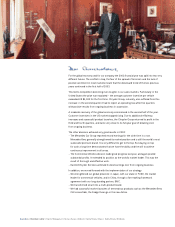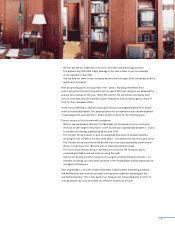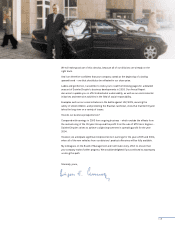Mercedes 2003 Annual Report Download - page 16
Download and view the complete annual report
Please find page 16 of the 2003 Mercedes annual report below. You can navigate through the pages in the report by either clicking on the pages listed below, or by using the keyword search tool below to find specific information within the annual report.
Essentials | Chairman’s Letter | Board of Management | Business Review | Outlook | DaimlerChrysler Shares | DaimlerChrysler Worldwide
Despite a renewed sharp increase in customer incentives, the US
automobile market contracted slightly to 17.0 million vehicles
(2002: 17.1 million). With total sales of 14.3 million vehicles (2002:
14.5 million), the passenger-car markets of Western Europe were
also unable to stimulate global demand due to the region’s generally
weak economy. Whereas the markets of South America recovered
only gradually from their crisis of the prior year, the countries of
Central and Eastern Europe and above all, the emerging markets of
Asia – led by China – experienced market growth, in some cases
of a significant magnitude.
After the sometimes dramatic market slumps of recent years,
demand for commercial vehicles stabilized worldwide in 2003, but at
a low level. In North America, unit sales of heavy and medium-duty
trucks did not quite match the level of 2002, and in Western Europe
new registrations were again slightly below the prior-year levels.
In Japan, purchases brought forward due to forthcoming stricter
emission laws for metropolitan areas led to a significant boost in
demand.
Unit sales of 4.3 million vehicles. Reflecting weak demand in
major markets, DaimlerChrysler sold 4.3 million passenger cars and
commercial vehicles in 2003 (2002: 4.5 million) but did not reach
the high level of previous year.
The Mercedes Car Group division performed very well under
difficult conditions. Unit sales of 1.2 million vehicles almost reached
the high level of the previous year. The division strengthened its
leading position in the premium segment worldwide (see pages 46 ff).
The Chrysler Group sold 2.6 million vehicles of the Chrysler,
Jeep®and Dodge brands in 2003. Increasingly tough competition
was the key factor behind the 7% decrease (see pages 50 ff).
Despite the continuation of difficult market conditions, the
Commercial Vehicles division sold 501,000 trucks, vans and buses
in 2003 (2002: 485,400) and thus exceeded previous years’ level
by 3% (see pages 54 ff).
Group revenues of €136.4 billion (2002: €147.4 billion). Due
to the lower level of unit sales and the appreciation of the euro
against the US dollar, total revenues decreased by 7% to €136.4
billion in 2003. Adjusted to exclude currency translation effects,
revenues were 3% higher than in the prior year.
Whereas Mercedes Car Group again increased its revenues thanks
to a more advantageous model mix, revenues at Chrysler Group
decreased significantly as a result of market and currency-translation
effects. Despite significant negative effects from currency
translation, the revenues generated by the Commercial Vehicles
division were just above the prior-year level. The fact that the
Services division’s revenues were lower than in 2002 was due to
the appreciation of the euro against the dollar.
In regional terms, DaimlerChrysler’s revenues generated in the
European Union increased by 4% to €47.8 billion. In the NAFTA
region, revenues decreased by 16% to €72.4 billion, mainly due to
the lower unit sales of the Chrysler Group; adjusted for currency
translation effects, there was a much lower reduction of 2%.
Revenues generated in the rest of the world rose by 8% to €16.2
billion.
362,063 employees. At the end of 2003, DaimlerChrysler
employed 362,063 people (end of 2002: 365,571). Compared with
the prior year, the number of employees increased slightly at
Mercedes Car Group, Commercial Vehicles and Services , while
the Chrysler Group’s workforce decreased as a result of its
restructuring activities. The sale and deconsolidation of the MTU
Aero Engines business unit at the end of 2003 resulted in a
decrease of about 8,400 employees at the Group. (See pages 78 f).
Optimized procurement processes. In 2003, we gave our
procurement processes even more international reach. Furthermore,
we prepared a list of measures to be taken in close collaboration
with our suppliers with the aim of achieving continuous improvements
in quality. Worldwide, DaimlerChrysler purchased goods and
services worth €99.7 billion in 2003 (2002: €102.1 billion). Of this
total, 40% was accounted for by Mercedes Car Group, 34% by
the Chrysler Group, 23% by Commercial Vehicles and 3% by other
units. (See pages 74 f).
€12.2 billion invested in the future. Last year, DaimlerChrysler
invested €6.6 billion in property, plant and equipment (2002:
€7.1 billion) and €5.6 billion in research and development (2002:
€5.9 billion). Major investments were made by Mercedes Car
Group to extend the Rastatt and Tuscaloosa plants for the production
of the new A-Class and M-Class series, and to prepare for the
production of the new smart forfour. The main investments
for the Chrysler, Jeep®and Dodge brands involved modifying the
plant in Newark for the production of the new Dodge Durango,
and expenditures for the nine new models in 2004.
























